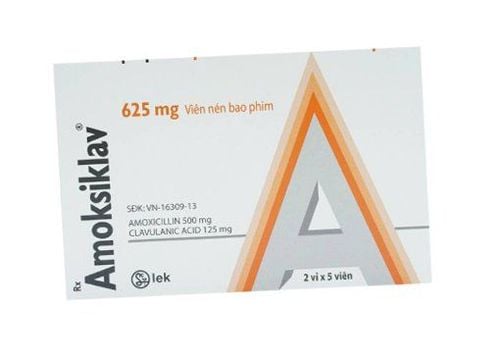This is an automatically translated article.
The drug vitabactam is a combination of two drugs including Cefoperazone and Sulbactam. In particular, the ingredient cefoperazone is an antibiotic, which works by preventing the formation of a protective bacterial coating that is necessary for the survival of bacteria. At the same time, sulbactam is a representative of beta-lactamase inhibitors, synergistically reducing resistance, thus enhancing the activity of Cefoperazone against bacteria. As a result, vitabactam is useful in the treatment of moderate to severe infections in many organ systems.1. Introduction to Vitabactam
Vitabactam is a combination of two antibiotics: Cefoperazone (belonging to the Cephalosporin antibiotic group) and Sulbactam (a beta-lactamase inhibitor). Cefoperazone's mechanism of action is by preventing the formation of a bacterial cell coating, which is necessary for their survival and thereby killing the bacteria. On the other hand, Sulbactam works by reducing bacterial resistance and enhancing the action of Cefoperazone against bacteria. As a result, Vitabactam is used to help treat bacterial infections. As such, Vitabactam belongs to the group of antibiotics used to treat various bacterial infections such as respiratory tract (lung) infections, urine infections, blood infections, meningitis (inflammation of the brain) and spinal cord), gonorrhea (sexually transmitted disease), skin, abdominal, bone and joint infections.Bacterial infections are caused by the multiplication of harmful strains of bacteria inside or on the body. Infectious or harmful bacteria can cause disease and multiply rapidly in the body, causing structural and functional damage to organs. These harmful bacteria produce chemicals called toxins, which can damage tissue and deplete the body. At this time, Vitabactam is not intended for viral infections, including colds and flu.
2. Notes when using Vitabactam
Before starting Vitabactam, please inform your doctor if you have a history of allergies (especially to any antibiotics), kidney or liver problems. Do not take Vitabactam without your doctor's prescription. Because self-medication can lead to antibiotic resistance, where antibiotics don't work against specific bacterial infections. Always consult your doctor before taking Vitabactam if the patient is a woman who is pregnant or planning to become pregnant. Avoid taking Vitabactam if you are breast-feeding as it may pass into breast milk. Avoid drinking alcohol while being treated with Vitabactam to prevent unpleasant side effects.
3. Instructions for using Vitabactam
In adults, the maximum daily dose of Vitabactam should not exceed 12g. Dosage and route of administration are considered according to the susceptibility of the causative organism, the severity of the infection, and the patient's condition.
How to use Vitabactam in each indication as follows:
Preoperative prophylaxis: 1g intravenously in 30-90 minutes before surgery. Caesarean section: The first dose is 1g intravenously immediately after the umbilical cord is clamped. Administer 2nd and 3rd doses of 1g intravenously every 6 hours and 12 hours after the first dose. Gonorrhea: Disseminated coccidiosis: 500mg IV 4 times/day for at least 7 days. Gonococcal ophthalmopathy: 500 mg IV 4 times/day for penicillinase-producing N. gonorrhoeae (PPNG). In pediatric patients, it is not necessary to distinguish preterm infants from normal infants and the dose should be calculated based on the child's weight. In patients with renal impairment, the determination of dosage will depend on the degree of renal impairment, the severity of the infection, and the susceptibility of the causative organism. In patients with a glomerular filtration rate less than 20 mL/min/1.73 m2, the dose of Vitabactam should be reduced by up to ⁄2 the dose. When using Vitabactam, use only freshly prepared solutions. The white to pale yellow color of the Vitabactam solution after reconstitution has not been shown to be related to drug quality or to a decrease in antibiotic potency.
The duration of treatment with Vitabactam depends on the patient's response. Vitabactam should be continued for at least 3 days after the body temperature returns to normal. Vitabactam is best given intravenously. The 250mg dose is dissolved in at least 2mL of water for injection. Doses of 500mg and 1g are dissolved in at least 4 mL of water for injection and then administered directly over a 3-5 minute period into a vein or into the distal portion of a clamped infusion tube. For intermittent intravenous injection, a solution containing 1 or 2 g in 10 mL of sterile water may be injected over a 3-5 minute period.
4. Vitabactam side effects
When using Vitabactam, patients may experience the following side effects:
Loose stools; Nausea, vomiting; Headache; Fever, chills; Allergic reaction; Pain and soreness at the injection site; Rash with skin redness (maculopapular rash); Light red and swollen skin (urticaria); Abnormal blood cell counts. Therefore, in order to limit side effects, doctors need to be especially careful before taking Vitabactam if the patient has a hypersensitivity to penicillin, colitis, kidney failure and other gastrointestinal diseases. In addition, dose reduction may also be necessary if the patient already has liver dysfunction, alcoholism, malabsorption or poor nutrition. If you are on a prolonged hyperpigmentation regimen, there is a high risk of vitamin K deficiency when taking Vitabactam.
In summary, Vitabactam for injection belongs to the group of third generation Cephalosporin antibiotics. Vitabactam is used to treat infections caused by Pseudomonas bacteria that are resistant to this group of antibiotics. Vitabactam works by inhibiting the synthesis of the bacterial cell wall, preventing the bacteria from growing, which will eventually kill the bacteria. Depending on your medical condition, medical health, age, body weight, and response to the medication, your doctor will prescribe a specific dose to achieve optimal infection control and limit the risk of infection. antibiotic resistance.
Please dial HOTLINE for more information or register for an appointment HERE. Download MyVinmec app to make appointments faster and to manage your bookings easily.













